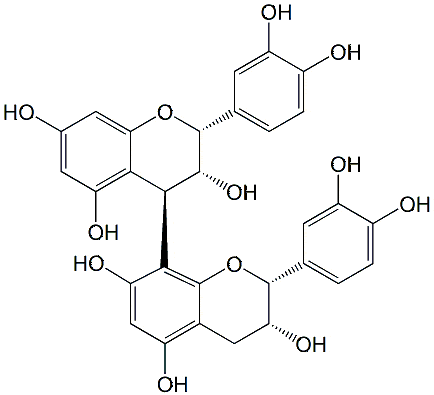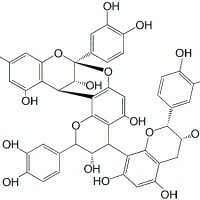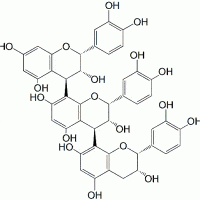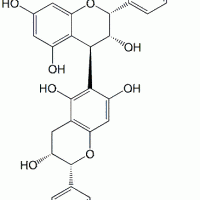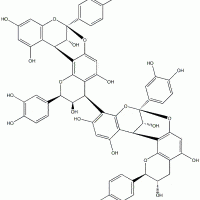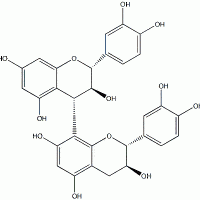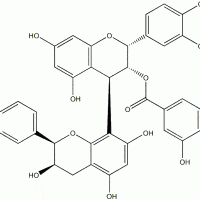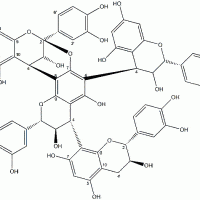- Required Weight missing.
Abstract
(+) catechin and (-) epicatechin form proanthocyanidins, including procyanidins. Procyanidins can be categorized into A-type and B-type, depending on the nature of the interflavan bonds. B-type procyanidins have a single interflavan bond. A-type procyanidins have not only one interflavan bond, but also a second interflavanoid bond. The most common B-type procyanidins are B1, B2, B3, and B4. Procyanidin B2 (CAS 29106-49-8) is an epicatechin-(4β→8)-epicatechin dimer. Cinnamon, cocoa, and apples contain procyanidin B2.
Recent research indicates that Procyanidin B2 (CAS 29106-49-8) is a protein kinase inhibitor, promoting hair epithelial cell growth and stimulating anagen induction. Furthermore, B2 demonstrates other bioactivities and, therefore, possesses the potential to treat a wide range of diseases, such as diabetes mellitus, atherosclerosis, and non-alcoholic fatty liver disease.
You can find additional procyanidin reference standards here.
Compound Details
| CAS | 21906-49-8 |
|---|---|
| Molecular Weight | 578.52 |
| Chemical Formula | C30H26O12 |
| IUPAC | (2R,3R)-2-(3,4-dihydroxyphenyl)-8-[(2R,3R,4R)-2-(3,4-dihydroxyphenyl)-3,5,7-trihydroxy-3,4-dihydro-2H-chromen-4-yl]-3,4-dihydro-2H-chromene-3,5,7-triol |
| Synonyms | – |
| SMILES | C1C(C(OC2=C1C(=CC(=C2C3C(C(OC4=CC(=CC(=C34)O)O)C5=CC(=C(C=C5)O)O)O)O)O)C6=CC(=C(C=C6)O)O)O |
| Purity | 98%+ |
| Storage Temperature | Below -18 degrees C |
| Storage Conditions | Dry, freezer |
Product Use Disclaimer
Products are sold as laboratory reference materials, to be used for diagnostic and in vivo testing. The samples are not certified for veterinary or human use.
$9.00 - $18.00 / milligram
| Range (milligram) | Price ($/milligram) |
|---|---|
| 5 - 24 milligram | $18.00 / milligram |
| 25 - 99 milligram | $16.00 / milligram |
| 100 - 249 milligram | $14.00 / milligram |
| 250 - 499 milligram | $11.50 / milligram |
| 500 - 1000 milligram | $9.00 / milligram |
Technical Support
Product information is from published literature. Due to the nature of scientific experimentation, results or specific product application may vary (e.g., selectivity, detector response). If you have questions about the product, its application, and associated analytics, please contact our technical support team.
Related products
-
View Item
Cinnamtannin B1 – CAS 88082-60-4
$28.00 - $42.00 / milligram -
View Item
Procyanidin C1 – CAS 37064-30-5
$18.00 - $43.00 / milligram -
View Item
Procyanidin B5 – CAS 12798-57-1
$36.00 - $72.00 / milligram -
View Item
Arachistannin G
PRICE ON REQUEST -
View Item
Procyanidin B3 – CAS 23567-23-9
$22.00 - $40.00 / milligram -
View Item
Procyanidin B2-3″-O-gallate Reference Standard
PRICE ON REQUEST -
View Item
Cassiatannin B
$41.00 - $60.00 / milligram


